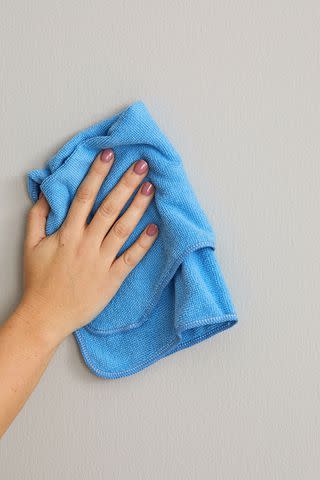How to Clean Walls to Remove Scuffs and Stains
Keep painted walls looking fresh with preventive maintenance and these simple cleaning methods.
You frequently mop your floors and vacuum your rugs, but when was the last time you cleaned the walls? Considering how much we lean against and touch them on a daily basis, keeping your walls clean is just as important as cleaning other household surfaces. Plus, over time, painted walls can accumulate stains, marks, shoe scuffs, and dust that give the surface a dull, dirty appearance. To preserve that freshly painted look, plan to wipe down your walls regularly. However, walls with different paint types and finishes require special care when scrubbing. Before you add this chore to your whole-house cleaning schedule, read our tips to learn how to clean walls without removing paint.

How to Clean Painted Walls
The first thing you should consider when washing painted walls is the finish. If needed, reference our handy guide to paint finishes. Whether the finish is glossy or flat will determine how scrubbing will affect the look of the wall.
How to Clean Walls with Flat Paint
Duller paint finishes, including flat, satin, and eggshell finishes, are less durable when it comes to cleaning. Do not use harsh chemicals or degreasers when cleaning flat painted walls. When washing with a sponge, be sure not to scrub too hard. The sponge should be wrung out almost completely before putting it on the walls.
What You Need
Water
Sponge
Microfiber cloth
Step 1: Wipe Walls
Dampen sponge. Wring out until almost dry. Gently wipe walls.
Step 2: Dry Walls
Wipe walls with a dry microfiber cloth.
How to Clean Walls with Glossy or Semigloss Paint
Because these paints are highly durable, they're most commonly used in high-traffic areas like the kitchen and bathroom. It's OK to use a mild degreaser on glossy kitchen backsplashes or vanity doors. Although glossy and semigloss paint is durable, it will still scratch, so always use a soft sponge when cleaning walls.
What You Need
Sponge
Dish soap
Water
Microfiber cloth
Step 1: Mix Soap and Water
Add a drop of dish soap to a bowl of warm water. Mix together.
Step 2: Clean Walls
Dampen the sponge in the mixture and wring it out almost completely. Gently wipe walls.
Step 3: Dry Walls
Wipe walls with a dry microfiber cloth.
How to Clean Walls with Latex Paint
What You Need
Non-abrasive all-purpose cleaner
Warm water
Sponge
Microfiber cloth
Step 1: Mix Cleaner and Water
The best way to clean walls painted with latex paint is to use warm water and a non-abrasive all-purpose cleaner.
Step 2: Clean Walls
Dip a clean sponge in the mixture, then wring it dry. Gently rub the wall. Pay special attention to areas that get touched often, such as around doorknobs and light switches. Rinse with a second sponge and clear water. Take care not to wet areas around outlets, light switches, telephone jacks, and other electrical connections. If scrubbing those spots is necessary, turn off electricity at the circuit breaker box.
Step 3: Dry Wall
Wipe walls with a dry microfiber cloth.
Editor's Note: For stubborn spots, such as fingerprints, newspaper smudges, or scuffs, make a paste of baking soda and water and rub the area with a nonabrasive pad. If cleaner (or white vinegar and water) doesn't remove the grime or stain on painted woodwork, wipe the woodwork with a rag dampened with rubbing alcohol.
How to Clean Walls with Oil-Based Paint
What You Need
Dish soap
White vinegar
Warm water
Sponge or clean cloth
Microfiber cloth
Step 1: Make Homemade Cleaning Solution
Stir 1 tsp. of liquid dish soap into a quart of warm water. Add 1/4 tsp of white vinegar. Let the solution sit on the stain for 10 minutes before using.
Step 2: Clean Walls
Wring the sponge or cloth until only slightly damp. Gently wipe walls. TIP: Texture-painted walls, such as those with a troweled finish, can be dust catchers and might require deeper cleaning. Add 1 ounce of borax to each pint of water to clean the wall.
Step 3: Dry Walls
Wipe walls with a dry microfiber cloth.
How to Clean Stains from Painted Walls
To clean wall stains, you'll want to act promptly. The sooner you can wash the stain, the better chance you have of removing it. Luckily, you likely have the best product to clean walls already in your pantry.
What You Need
Baking soda
Warm water
Clean cloth
Microfiber cloth
Step 1: Mix Baking Soda and Water
Mix a few tablespoons of baking soda with warm water until a paste forms.
Step 2: Apply Mixture to Stain
Gently work the formula into the wall stain. Wipe away any residue with a clean, damp cloth. The gentle abrasive works especially well on grease wall stains.
Step 3: Dry Walls
Wipe walls with a dry microfiber cloth.
:How to Clean Crayon Off Walls

How to Make All-Purpose Cleaner for Wall Stains
Not all wall stains come out easily. You might need more than a little water to remedy the situation. This all-purpose detergent can be used for oil-based painted walls. Adjust the recipe as needed for the size of your wall or stain.
What You Need:
Liquid dish detergent
Distilled white vinegar
Step 1: Mix Solution
Stir 1 tsp. of liquid dish detergent into a quart of warm water. Add 1/4 tsp. of white vinegar.
Step 2: Apply Solution
Let the solution sit on the stain for 10 minutes before blotting. To prevent color from transferring from your towel to your walls, use a white lint-free rag or microfiber cloth.

How to Prevent Dirty Walls
Maintain a freshly painted look on your walls by keeping them free of dust and spots. Practicing preventive maintenance means less time spent scrubbing walls later.
To help keep walls clean, vacuum painted walls with a soft brush attachment. Then wipe them down with a cloth-covered broom or mop (spray with a dusting agent for best results), or use an electrostatic dusting wipe. Wipe away fingerprints and other marks like sticker residue soon after they appear. Avoid using an excessive amount of water when cleaning painted walls to prevent drips.

